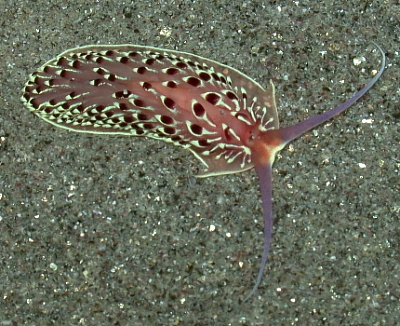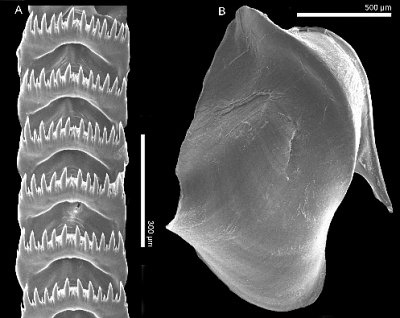Cerberilla chavezi - new aeolid from the eastern Pacific
August 2, 2007
From: Alicia Hermosillo


Dear Bill,
Here is a bit about this newly described aeolid, Cerberilla chavezi, from the tropical eastern Pacific (TEP).
Cerberilla is a genus that is characterized by a wide body, short cerata, very long oral tentacles and small and simple rhinophores. The wide body helps them move around muddy soft bottoms and the small rhinos make it easier to burrow, usually during the day time or when disturbed by dive lights during the night. The radula has only one tooth [in each row], which is wide and denticulated.
Cerberilla chavezi is very colorful and disctinct. You can see that the very long purple oral tentacles are pulled back when burrowing.
Locality: Manzanillo, 20 feet, Colima, Mexico, tropical eastern Pacific, 23 March 2004, Muddy bottom. Length: 18 mm. Photographer: Ali Hermosillo.
So far, I have only found this species in Bahia de Banderas and Manzanillo (Pacific coast of Mexico). It will be very interesting to find out if other divers find it elsewhere. Look for muddy bottoms with scattered algae and hydroids... then go diving at night and be quick! It will burrow as soon as it feels the light. You will probably need a buddy to help you photograph it.
Cheers!
Ali
gueri25@hotmail.com
Hermosillo, A., 2007 (Aug 2) Cerberilla chavezi - new aeolid from the eastern Pacific. [Message in] Sea Slug Forum. Australian Museum, Sydney. Available from http://www.seaslugforum.net/find/20362
Thanks Ali,
-
Hermosillo A. & Valdés, A. 2007. Five new species of Aeolid nudibranchs (Mollusca, Opisthobranchia) from the Tropical Eastern Pacific. American Malacological Bulletin, 22: 119-137, 13 text figures, 1 color pl.
Best wishes,
Bill Rudman
